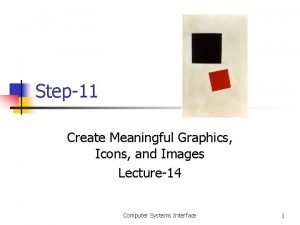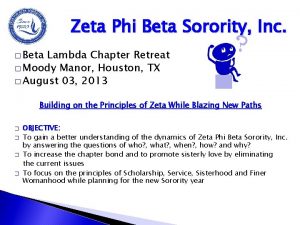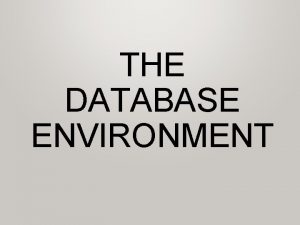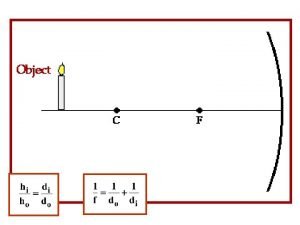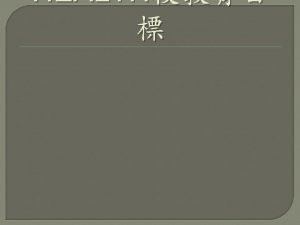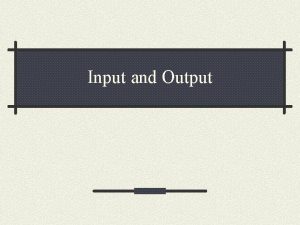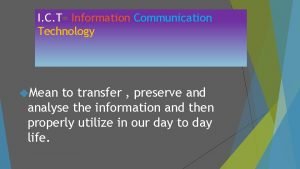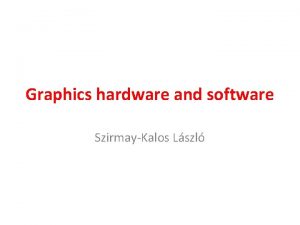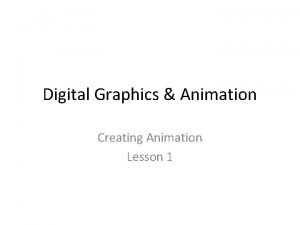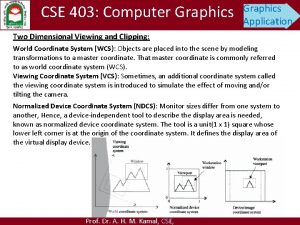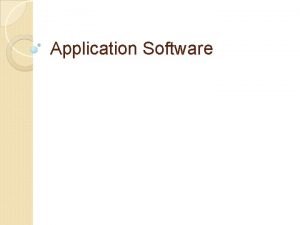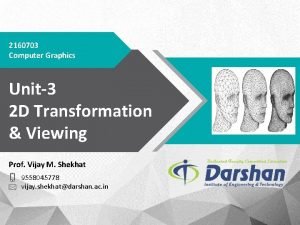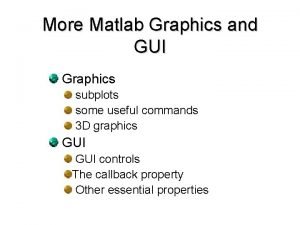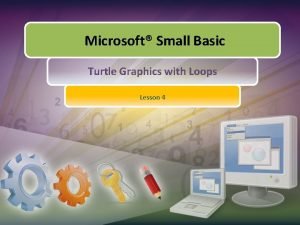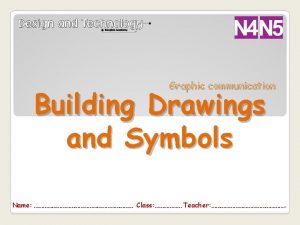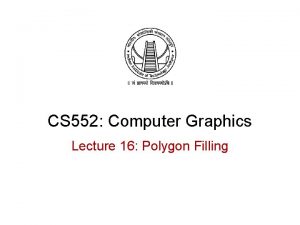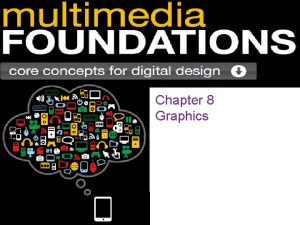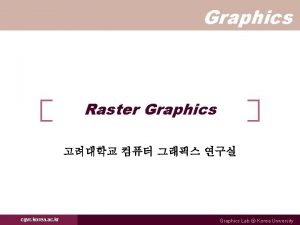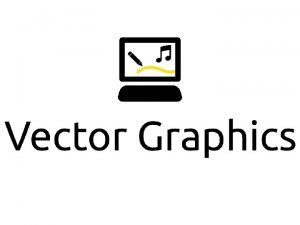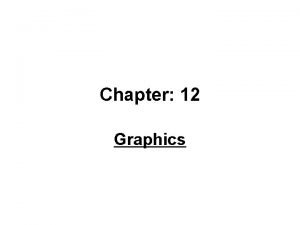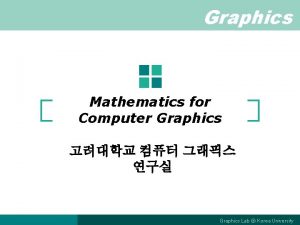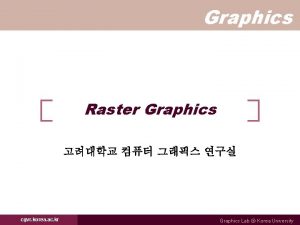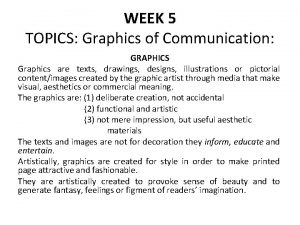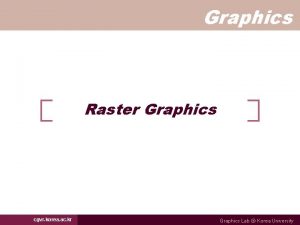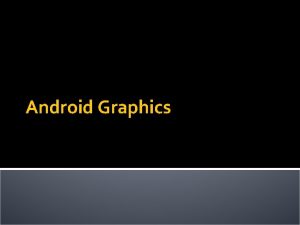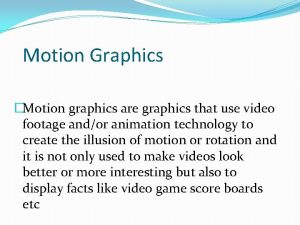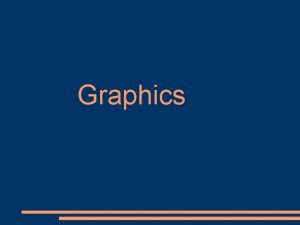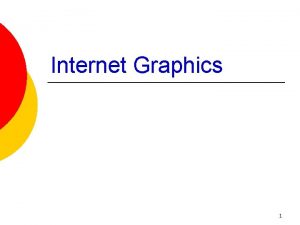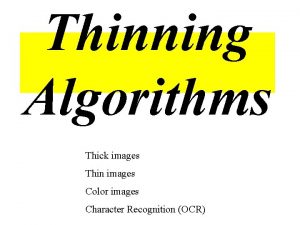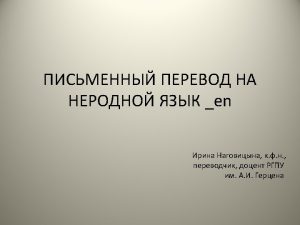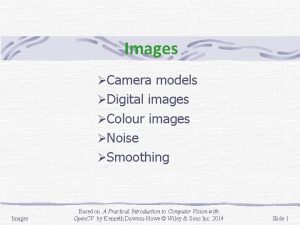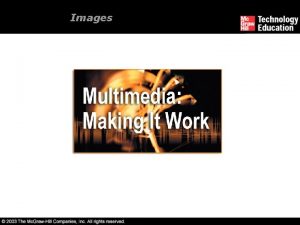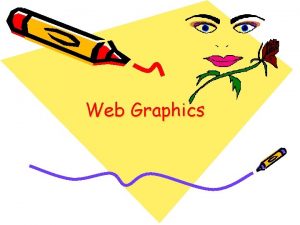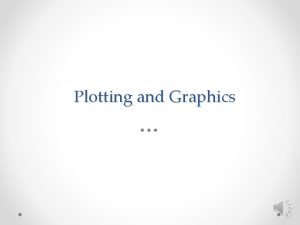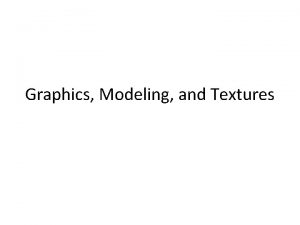FMUSEUM 3 D images 1 Images and graphics

























- Slides: 25

F-MUSEUM: 3 D images 1

Images and graphics are a fundamental source of communication. 2 D and especially 3 D graphics are quickly becoming an integral part of dynamic, interactive web sites. Following is a description of some 3 D graphics software currently available. • The objectives of this section consist in: • To know how to use the main software for realizing the images in 3 D; • To know how to converse profitable with the professional figures of the expert of the contents and with the project leader. 2

SOFTWARE 3 D OBJECT MODELLER 3 DSOM from Creative Dimension Software Ltd. is a fast, cost-effective software tool for generating photo-realistic 3 D models from images of real objects, based on technology originally developed by Canon. With the 3 DSOM Viewer Java applet, interactive plug in-free 3 D content can easily be created for compelling e-commerce sites, eyecatching internet advertising, online museum exhibitions, and more. A fully customised 3 D modelling service is also available delivering high quality multimedia content for CD marketing campaigns, exhibitions, education, digital product brochures and streaming over the internet: http: //www. 3 dsom. com/features/process. html ttp: //www. 3 dsom. com/proexamples/index. html 3

Specifications a) Input Images • Mat printing function to create calibration mats on an ordinary black and white printer. • Accepts up to 256 input images per project from digital cameras or scanners as JPEG, BMP or PNG files; • Fully automatic, robust camera calibration to identify arbitrary camera location and orientation; • Automatic background separation (masking) tool with compensation for shadows on the backdrop; • Manual mask editing tools at multiple image zooms; • Mask save and load via PNG for editing in an external editor (Adobe Photoshop, JASC Paint Shop Pro and others). 4

Specifications: Save and Export • • • Export final model to 3 DSOM Viewer for immediate inclusion on web pages without need for browser plugins. We can also remove our branding on a permodel basis; 3 DSOM Viewer can display a background image behind the model as well as adding lighting, shadows and hotspots in a small redistributable Java applet; Export to Shockwave for use in Macromedia Director 8. 5 for creating interactive web content, and also as ready-to-use web page for use with popular Shockwave Player plugin; Export to VRML for interchange with many 3 D packages and also for viewing with VRML-enabled browsers; Export to 3 DS object for loading into 3 D Studio Max and other 3 D editing/animation packages; All project information saved in one project file; Original images are not altered (can be read only) and left outside file to minimise project file size. e) System Requirements 3 DSOM runs under Windows XP (Home or Professional Editions) or Windows 2000. Although it is possible to run under a Windows emulator on a Macintosh, this is not recommended as intensive processing is required. 5

VR WORX 2. 6 Quick. Time Virtual Reality is an extension of the Quick. Time technology developed by Apple Computer, Inc. that allows viewers to interactively explore and examine photo realistic, three-dimensional, virtual world. Unlike many other virtual reality systems, Quick. Time VR does not require the viewer to wear goggles, a helmet or gloves. Instead, the viewer navigates in a virtual world using conventional computer input devices (such as the mouse, trackball, track pad or keyboard) to change the displayed image via the Quick. Time VR movie controller. Quick. Time VR is quickly becoming one of the most important assets you can have, bringing a new level of interactivity and motion to web design and multimedia productions. The user can create interactive Quick. Time VR movies quickly, simply and professionally, with any kind of camera: film, digital, video or created on the computer using a threedimensional (3 D) graphics package. 6

• The VR Worx 2. 6 can construct multinode environments with cylindrical panoramas, cubic VRs, multi-row objects, absolute objects, objects with sound, still images and linear Quick. Time movies (http: //www. vrtoolbox. com/gallery. html). • New Features & Functions Include: • Streamlined and simplified User Interface for Macintosh & Windows; • Live Scrolling, Live Window Resizing and Dialog Sheets; • Application-wide Image Drag & Drop, including Document Proxy Icons; • Integrated On-line Help; • Intelligent Auto-configuration of Panoramas & Objects; • Choice of Cylindrical or Linear input acquisition mode for Panoramas; • Integrated Bridge to external image editors, like Photoshop™; • Zoom capability for images in Stitch & Blend panels; • Drag & Nudge capability for positioning images in Stitch panel; • User defined presets for quick composition of Quick. Time movies; • Specify alternate target sizes with estimated download times; 7

PHOTOMODELER • • • Photo. Modeler is a powerful 3 D software product that calculates measurements and constructs 3 D models from your photographs simply and easily (http: //www. photomodeler. com/app 03. html). Photo. Modeler is used by professionals around the world to: Create "as-built" drawings and measurements for process and plant engineers; Measure accident and crime scenes forensic analysts; Create "as-found" and "as-built" drawings for architects and historic preservationists; Model sets, objects, people and vehicles for animators and film/video producers; Measure and create drawings of buildings, excavations & artefacts for archaeologists; Measure and model anatomical morphology for anthropologists and medical practitioners; Reverse-engineer mechanical parts and assemblies for manufacturing engineers; Survey complex 3 D shapes, structures and volumes for civil engineers and surveyors; Model objects for 3 D databases for virtual reality builders. 8

PIXMAKER PRO • Following the simple 3 steps of Snap, Stitch, Publish!™ in Pix. Maker 1. 0, Pix. Maker Pro enables you to create 360° interactive Pix. Around content complete with Hotspots efficiently with customization options for Hotspot, Postcard and Web pages via its proven friendly, intuitive and easy-touse graphical user interface. • Pix. Around Scenes can be published online as Web pages, offline as Postcards, Screen Savers, Power. Point® presentations; and onto mobile devices based on both Palm OS® and Windows® CE. You can create as many Pix. Around Scenes, Web pages, Postcards and Presentations as you wish at no additional cost. No additional software or browser plugins are not required for viewing the Pix. Around content. • (http: //www. pixaround. com/showcase/scenarios/loe-vangallery/web/gallery. asp) (http: //www. pixaround. com/showcase/scenarios/merlion/ind ex. asp) 9

Specifications • Snap • Capture your shots with ANY still camera; • Capture panoramic video with ANY USB/Fire. Wire based digital video camera; • Input formats: – – – – JPEG (. jpg) Bitmap (. bmp) Photo CD (. pcd) Tagged Image File (. tif) Portable Network Graphics (. png) AVI (. avi) MPEG-1 (. mpg) 10

DEEPENING: 3 D PHOTOGRAPHY A mobile camera set has been privileged in order to avoid duplications of the operations, so time wasting. By virtue of the mobile set, every photographic session – about ten objects per time – took two days by 7 -8 working hours each. The crucial requirement for VR photographing consists of the possibility to turn the reference object around one of the axes passing through the central-point. With this purpose in mind, we use a rotating base with a diameter of about 40 cm which should a) be able to sustain the heaviest objects and, mostly, b) allow for fluent and stable movements. 11

In the picture below, for instance, we found that, at least, 24 pictures are required in order to allow for an adequate description of the object in the 3 D framework. At the end we opted for 36 pictures. 12

Lightening In order to lighten the objects, one single lamp has been placed on the flank of the camera. The shadowed part of the object has been cleared up through some small reflecting panels and a mirror, where the latter allows to concentrate the light on single parts of the objects with adequate precision and, in addition, it is not problematic to transport from one set to another. 13

14

The camera • All the pictures have been taken by a digital reflex Nikon D 70. The use of a professional reflex has been very important for the success of this job. In addition, the camera should be fixed to a robust tripod. Two optics have been mostly used: the Micro Nikkor 60 mm f 2, 8 AF-D and the Micro Nikkor 105 mm f 2, 8 Ai. These two optics allowed us to photograph all of the objects with low effort and high quality results. • The focus of the camera should be manually regulated and held still during the rotation, taking care in advance about the maximum width of the object. Sufficiently closed diaphragms have been used in order to give the maximum depth to the object. • The exposition as well, has to be manually regulated and held fixed with remaining white balancing and the set up of ASA: it should be clear that all of the 36 pictures should have the same length and colour parameters in order to avoid chromatic variations and alterations during the rotation. 15

Digital elaboration • The 36 pictures have been taken in RAW format; next the pictures have been elaborated by the less heavy Jpg format, settled up at the minimum compression. Since the retouch of all pictures would have been too much effort-demanding, we have tried to achieve a good quality of pictures since the beginning, using, when opportune, non invasive supports in harmony with the rest of the object. The final assemblage of the sequence of pictures has been realized with the software “Quick Time VR” which allows for a sufficient number of user-friendly regulating options. Unfortunately, this software exists uniquely for Mac PCs, but the final products can be used with Windows OS as well. 16

NEW TECHNOLOGIES it. Seez 3 D • it. Seez 3 D is a mobile 3 D scanner that allows your i. Pad, with the Occipital’s Structure Sensor, to capture color and structure information of the world and process them into realistic 3 D models. Use it to scan your family and friends as well as things you would like to copy in 3 D, e. g. , toys, shoes etc. Share your 3 D models on sketchfab. com from the app and become a part of the growing 3 D community! Other features include: • Capture high-resolution color and structure data • Augmented reality feedback is used to improve your scanning experience • Send captured data to the cloud and get a great 3 D model back in a few minutes • Share the 3 D model by email in. ply or. obj formats or on Sketchfab. 17

DIGITAL PHOTOGRAPHS How to create a 3 D relief using only digital images? • The first critical step is obviously the acquisition of good digital photographs. • At this stage it is certainly useful to use a camera, even if compact rooms and even smartphones have yielded good results. In certain situations it can be very helpful to use a tripod, especially indoors in low light where the risk of blurred images is very high; It is to avoid the use of flash. It may be useful in the use of a tripod in cases where the object to be photographed is particularly high and also it becomes impossible to take photographs of the highest part of the object. • When taking photographs you should always consider the three-dimensional object that is in front. To obtain an accurate and complete relief is essential to take pictures all around the object: on all sides, above and, if possible, even below. Each portion of the object must appear in at least three photos and each photo must have a margin of about 60% overlap with adjacent ones. • In practice, taking a first photograph, then we move a little 'side and they take another, and so on until you come full circle around the object and has not returned to the starting point (see video at the bottom of text); it is recommended to take a picture at least every 15 degrees of movement. 18

• Important not to use the zoom, or at least use the same zoom level. • The advice is to take lots of photos, at least a hundred, to eventually select the best and discard those that have problems. 19

And you need to pay special attention to the following aspects: • lighting is crucial: if it is low and the object is in shadow will get a poor result; similarly if the lighting is excessive and too direct object will get a poor result. This is because the algorithms behind the Imagebased Modeling rely on "texture" of photographs, too many gray areas, or too many areas of excessive light flatten the three-dimensional object making it difficult to reconstruct; • Photographs taken outside at different times of the day or even after a few days can cause problems as it will have different lighting; • it is not advisable to take pictures at very high resolution, unless you have access to a high-performance workstation for post-processing of images. If you are using a PC mid-level, such as a notebook, it will be almost impossible to process hundreds of photos over the 5 MP; • the best images for this type of processing are those taken from a distance such as to embrace each a good portion of the object to be detected and with a high degree of overlap, not only between adjacent images, but also between many images. 20

Interactive environments There are several types of interactive environments. One is to recreate 3 D space with visual representations of the museum by a 3 D architectural metaphor, Which Provides a sense of place using various spatial references. They usually you use 3 D modeling, VRML (Virtual Reality Modeling Language) and X 3 D now (successor to VRML) for viewing. There sono stati Introduced various kinds of imaging techniques for building virtual museums, such as infrared reflectography, X-ray imaging, 3 D laser scanning, IBMR (Image Based Rendering and Modeling) techniques. In the case of EU-funded projects, the Vi. HAP 3 D, a new virtual reality system for scanning museum artifacts, Has Been developed by EU researchers. [Citation needed] Another interactive threedimensional spatial environment is QTVR. 21

• VRML (Virtual Reality Modeling Language, pronounced vermal or by its initials, originally—before 1995—known as the Virtual Reality Markup Language) is a standard file format for representing 3 -dimensional (3 D) interactive vector graphics, designed particularly with the World Wide Web in mind. It has been superseded by X 3 D. • VRML is a text file format where, e. g. , vertices and edges for a 3 D polygon can be specified along with the surface color, UV mapped textures, shininess, transparency, and so on URLs can be associated with graphical components so that a web browser might fetch a webpage or a new VRML file from the Internet when the user clicks on the specific graphical component. Animations, sounds, lighting, and other aspects of the virtual world can interact with the user or may be triggered by external events such as timers. A special Script Node allows the addition of program code (e. g. , written in Java or ECMAScript) to a VRML files are commonly called "worlds" and have the *. wrl extension (for example island. wrl). VRML files are in plain text and generally compresses well using gzip which is useful for transferring over the internet more quickly (some gzip compressed files use the *. wrz extension). Many 3 D 22 modeling programs can save objects and scenes in VRML format.

Standardization • The Web 3 D Consortium has been formed to further the collective development of the format. VRML (and its successor, X 3 D), have been accepted as international standards by the International Organization for Standardization (ISO). • The first version of VRML was specified in November 1994. This version was specified from, and very closely resembled, the API and file format of the Open Inventor software component, originally developed by SGI. The current and functionally complete version is VRML 97 (ISO/IEC 14772 -1: 1997). VRML has now been superseded by X 3 D (ISO/IEC 19775 -1) 23

X 3 D is a royalty-free ISO standard XML-based file format for representing 3 D computer graphics. It is successor to the Virtual Reality Modeling Language (VRML). [1] X 3 D features extensions to VRML (e. g. CAD, Geospatial, Humanoid animation, NURBS etc. ), the ability to encode the scene using an XML syntax as well as the Open Inventor-like syntax of VRML 97, or binary formatting, and enhanced application programming interfaces (APIs). The X 3 D extension supports multi-stage and multi-texture rendering; it also supports shading with lightmap and normalmap. Starting in 2010, X 3 D has supported deferred rendering architecture. Now X 3 D can import SSAO, CSM and Realtime Environment Reflection/Lighting. The user can also use optimizations including BSP/Quad. Tree/Oct. Tree or culling in the X 3 D scene. X 3 D can work with other open source standards including XML, DOM and XPath. 24

Standardization • X 3 D defines several profiles (sets of components) for various levels of capability including X 3 D Core, X 3 D Interchange, X 3 D Interactive, X 3 D CADInterchange, X 3 D Immersive, and X 3 D Full. Browser makers can define their own component extensions prior to submitting them for standardisation by the Web 3 D Consortium. Formal review and approval is then performed by the International Organization for Standardization (ISO). • Liaison and cooperation agreements are also in place between the Web 3 D Consortium and the World Wide Web Consortium (W 3 C), Open Geospatial Consortium (OGC), Digital Imaging and Communications in Medicine (DICOM) and the Khronos Group. • A subset of X 3 D is XMT-A, a variant of XMT, defined in MPEG-4 Part 11. It was designed to provide a link between X 3 D and 3 D content in MPEG-4 (BIFS). • The abstract specification for X 3 D (ISO/IEC 19775) was first approved by the ISO in 2004. The XML and Classic. VRML encodings for X 3 D (ISO/IEC 19776) were first approved in 2005. 25
 Hand held computer
Hand held computer 3d viewing devices in computer graphics ppt
3d viewing devices in computer graphics ppt Meaningful icons
Meaningful icons Myrtle tyler
Myrtle tyler Facts, text, graphics, images, etc.
Facts, text, graphics, images, etc. Real vs virtual image
Real vs virtual image Hi
Hi Images search yahoo
Images search yahoo How to save images on google images
How to save images on google images Https://tw.images.search.yahoo.com/images/view
Https://tw.images.search.yahoo.com/images/view In two dimensional viewing we have?
In two dimensional viewing we have? Line drawing algorithms
Line drawing algorithms Scanners produce text and graphics on a physical medium
Scanners produce text and graphics on a physical medium Definetion of communication
Definetion of communication Vbo1
Vbo1 Line drawing algorithm in computer graphics ppt
Line drawing algorithm in computer graphics ppt Digital graphics and animation
Digital graphics and animation In two dimensional viewing system have
In two dimensional viewing system have Graphics & multimedia software
Graphics & multimedia software Reflection and shearing in computer graphics
Reflection and shearing in computer graphics Graphics and guis with matlab
Graphics and guis with matlab Small basic turtle graphics
Small basic turtle graphics Mathematical foundations of computer graphics and vision
Mathematical foundations of computer graphics and vision Graphic communication symbols
Graphic communication symbols Computer graphics chapter 1 ppt
Computer graphics chapter 1 ppt Region filling and clipping in computer graphics
Region filling and clipping in computer graphics


